Home » European History (Page 5)
Category Archives: European History
American Historian Abroad

By: Daniel Morgan (Class of 2013)
As an American studying abroad, the two most frequent questions I received over my regrettably brief stint in Edinburgh were, firstly, why I had decided to travel some thirty two hundred miles just to study history; and secondly, why someone born and raised in the States would be so interested in medieval history. Before I could even begin to answer these questions, though, I thought that I should first answer why so many people would think to ask me these same two.
It must have seemed baffling from the point of view of a UK citizen studying the humanities, and perhaps many European humanities students in general, to travel so far just to read the same books or listen to similar lecturers/professors expound upon the same subjects. After all, one of the most wonderful features of the humanities in general, and for me history in particular, is that it is concerned with a unified thought world, in which all philosophical partisanship is leveled out in the pursuit of “the truth,” or “meaning.” So, despite a few stylistic differences here and there, how is being taught history in a foreign country any different than studying history in one’s own country?
In this vein, the second question seems almost legitimate – what interest could an American possibly have in a history that is so far outside the realm of his own cultural and or personal experience? I suppose it must have seemed abundantly strange that the United States, lacking its own medieval past, could produce anyone interested in the medieval period at all. Yet a more important part of this question to some was in tacitly asking how an American could even hope to comprehend the true depth of a history not his own.
(more…)
Lecture: ‘How the Irish Became Black’ with Prof. Bruce Nelson

By Michael McLean (History major, Class of 2014)
Today’s history lecture titled “How the Irish Became ‘Black’: Irish Identity in the 19th Century” provided an in-depth look at Irish identity and race relations. After giving a brief historical context on Ireland (the potato famine, mass emigration, British imperialism, etc.). Historian Bruce Nelson of Dartmouth College provided a number of images and anecdotes which displayed how the Irish were indeed labeled as a black, “negroid” race in the US and England, far inferior to other white Europeans. For instance, the Irish frequently appeared in political cartoons depicted as ape-like creatures, and were described as lazy savages with dark skin. The arguments for this kind of thinking are of course ridiculous, if not outright laughable. Nevertheless, Nelson highlighted a vital phenomenon in the history of racial identity. It is now scientifically accepted that there is no biological basis for race, but rather a social construction, and skin color has no affect on personal characteristics (i.e. intellect or diligence). Still, concepts of race still dominate much of our lives in the US and act as a tool to perpetuate inequality. In this way, the lecture was a crucial reminder that race is not as fixed as many of us would like to believe, and what constitutes “blackness” has changed dramatically over the course of history.
Borden W. Painter Jr Lecture: Prof. Kathleen Kete
By: Carolyn Taratko (History, Class of 2012)
On Tuesday, February 7th Professor Kathleen Kete gave the inaugural Borden W. Painter Jr. Lecture in the McCook auditorium. Professor Kete lectured on her current project, a history of the Alps in the French Revolution. Using Horace Benedict de Saussure’s Voyage dans les Alpes (held in our own Watkinson Library) as a guide, she interrogates the relationship between natural and civil history in the eighteenth century. Saussure, a Genevan aristocrat, was also a naturalist and a climber whose 1787 summit of Mont Blanc captured the nation’s attention. His extended forays into the Alps resulted in extensive observations on botany, geology and glaciers, but also nuanced descriptions of the mountains and the people who inhabited them. These two spheres of inquiry, the first scientific and the second picturesque, were published separately in post-Revolutionary France.
(more…)
